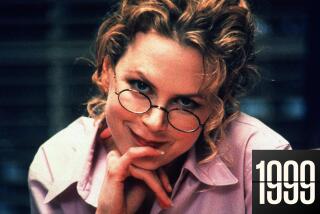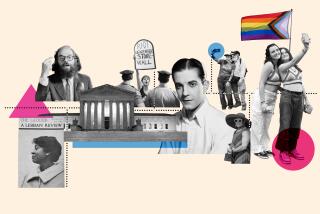‘Celluloid Closet’ Depicts History of Gays on Screen
- Share via
To watch the fascinating and illuminating “The Celluloid Closet” on HBO tonight--or to read the late Vito Russo’s landmark book upon which it is based--is to be made to realize that the movies, so beloved by so many gays and lesbians, have always been a major instrument of their oppression--perpetuating negative stereotypes from the earliest days, shaping the way they have viewed themselves and the way they have been viewed by straights.
Documentarians Rob Epstein and Jeffrey Friedman and their writer, Armistead Maupin, have done full justice to the book and to Russo, who was a major figure in Epstein and Friedman’s Oscar-winning 1989 “Common Threads: Stories From the Quilt.”
Russo, who died of AIDS complications in 1990, fought his disease and the government’s indifference to its spread and treatment with the same passion he dedicated to the years of research and writing of “The Celluloid Closet.”
Although the documentary is not nearly as international in scope as the book, it is able to conclude upon a more positive, encouraging note than Russo was. While the breakthrough, mainstream Hollywood movie for either gays or lesbians has yet to arrive--one in which the hero is a gay or lesbian who survives to a happy ending--the last decade has brought an array of independent features that depict gay lives in a forthright, unexploitative fashion.
From the very beginning, the movies have always been able to get an easy laugh from a limp-wristed male. Veteran playwright-screenwriter Arthur Laurents says he never was able to see what was funny about them, but actor-playwright Harvey Fierstein disagrees, believing also in “visibility at any cost” and saying, besides, “I am a sissy myself.”
With Lily Tomlin as narrator, “The Celluloid Closet” expertly surveys the decades, citing landmark movies and tracing the impact of the coming of the Production Code and the Legion of Decency, which forbade and condemned, respectively, the depiction of “sexual perversion,” and shows that clever writers and directors could get around such restrictions indirectly.
But in the post-World War II era, gays and lesbians gradually moved from being portrayed as victims to victimizers. A realistic depiction of gays and lesbians and their lives on the screen is in fact a relatively recent phenomenon.
Epstein and Friedman got lots of famous people to participate and to speak candidly. Shirley MacLaine is appalled to look back at “The Children’s Hour” (1962), in which she plays a self-loathing lesbian, and admits that “we were not understanding what we were doing.” Tom Hanks points out that, for all the acclaim accorded “Philadelphia,” he, a “non-scary type,” was after all playing a tragic figure.
Susan Sarandon probes the reasons why love scenes between women seem so much less threatening than love scenes between men, and an array of prominent gay and lesbian writers speak of how the movies affected their own lives.
“Philadelphia” screenwriter Rob Nyswaner says it all about the direct influence movies can have on perception and behavior when he recounts that, after enduring a gay-bashing, his attacker remarked, “If you saw the movie ‘Cruising,’ you know you deserved it.”
* “The Celluloid Closet” airs at 10 tonight on HBO. Sony Pictures Classics is releasing the film theatrically in key cities on March 15.
More to Read
Sign up for our Book Club newsletter
Get the latest news, events and more from the Los Angeles Times Book Club, and help us get L.A. reading and talking.
You may occasionally receive promotional content from the Los Angeles Times.








